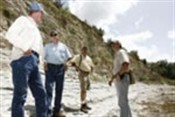Stream Team works to keep the land from washing away
July 2008
by Fred Afflerbach – Telegram Staff Writer
“We all agree that there’s a problem going on within the watershed and it’s not disconnected,” said Jason McAlister, a research assistant at the Blackland Research Center in Temple. “Do not pretend for one minute that you’re isolated from your neighbor downstream. Whatever you do has an impact and whatever they do might have an impact on you.”
With the July sun bearing down like a celestial heat lamp, it’s hard to imagine the slow trickle of the South Branch of Salado Creek could wreak such destruction.
But last May, Salina Brown watched terrified as floodwaters washed out her backyard and lapped up inside her home.
“It happens fast,” said Brown, standing under an elm tree waving her hands in a churning motion. “This is boiling up right here. We had a hole where we’re standing about 10 feet deep.”
After floods twice washed out their backyard, the Browns took out a loan to cover repair costs – about $10,000. Brown said before they bought the house county engineers informed them they were not in the floodplain. So they didn’t buy flood insurance.
Salado alderwoman Carol Walls said the creek flooded several backyards in the neighborhood last May. One man opened his front and back door, and watched helplessly as water gushed through his house. Another house had floodwater come in through the front window. And one man built a brick retaining wall to keep the floodwaters at bay.

Jim Kelly, wildlife biologist with Natural Resources Conservation Service; Jim Herrington, wetland biologist with Environmental Protection Agency; Jason McAlister, assistant research scientist with Blackland Research Center; and Tom Heger, with Texas Parks and Wildlife Department, on Wednesday discuss possible solutions to curb the flooding and erosion along the Smith Branch of Salado Creek. –photo by Scott Gaulin/Telegram
Stream Team members discussed solutions such as building diversion ponds and planting riverbank vegetation to prevent erosion. But they work in an advisory capacity only, a sort of riverbank brainstorming session.
McAlister said repairing flood damage to riverbanks is comprehensive. All parties involved need to be on board, or time and money may be wasted. Band-Aids don’t work.
“You have to think in terms of the big picture. Some people don’t like to get in the middle of big political things and I can understand that,” said McAlister. “But if you can, the right communication going in can be beneficial in so many ways.”
Ms. Walls said the Federal Emergency Management Agency was conducting a study regarding the flooding.
Over in Milam County, Kit Worley has built a campground and live music venue on the banks of the San Gabriel River, land that has been in his family for more than 100 years.
Worley has done some riverbank restoration on his own. He’s converted one steep cliff into a grassy slope. And in another spot he’s stabilized the bank with large chunks of concrete salvaged from a demolition project. But he has more work to do, and by all accounts the work is expensive.
“We have losses. How would we start the process to get some money in here to help plant these grasses and do some streambank restoration?”
Standing near a doomed sycamore clinging precariously to the riverbank, Environmental Protection Agency wetland biologist Jim Herrington offered a possible starting point. He said a development program through the EPA is available if the individual works through a government entity.
The Stream Team also visited an organic pecan farm on the Little River near Texas Highway 95. Members discussed clearing a logjam created by washed out cottonwood and pecan trees. Repairing steep sandbanks, a result of decades of erosion, posed a more difficult problem.
The group also advised one landowner about proactive measures. A landowner on Boggy Creek, in south Temple, has little erosion today, but was seeking feedback regarding preventive measures.
–Reprinted with permission of Temple Daily Telegram
Years of Central Texas thunderstorms have spawned recent brainstorms regarding waterway erosion. Earlier this week, a group of state and federal biologists and engineers called the Stream Team witnessed stark evidence from years of flooding on the San Gabriel, the Little River, and on a branch of Salado Creek. Caved banks, washed out backyards, and tree trunks scattered like toothpicks provide a grim reminder what can happen when the heavens quickly open and once placid waterways turn destructive.
